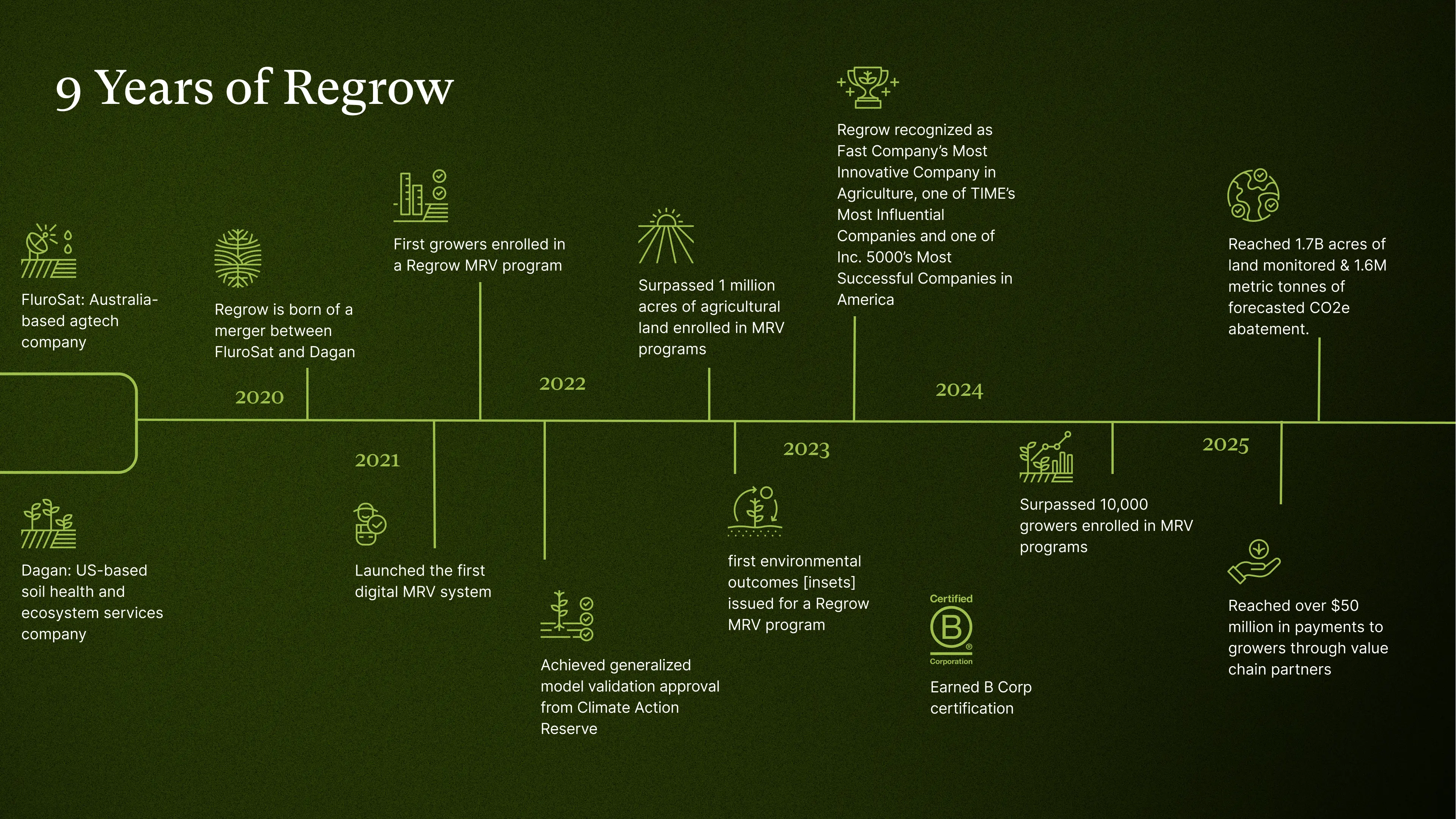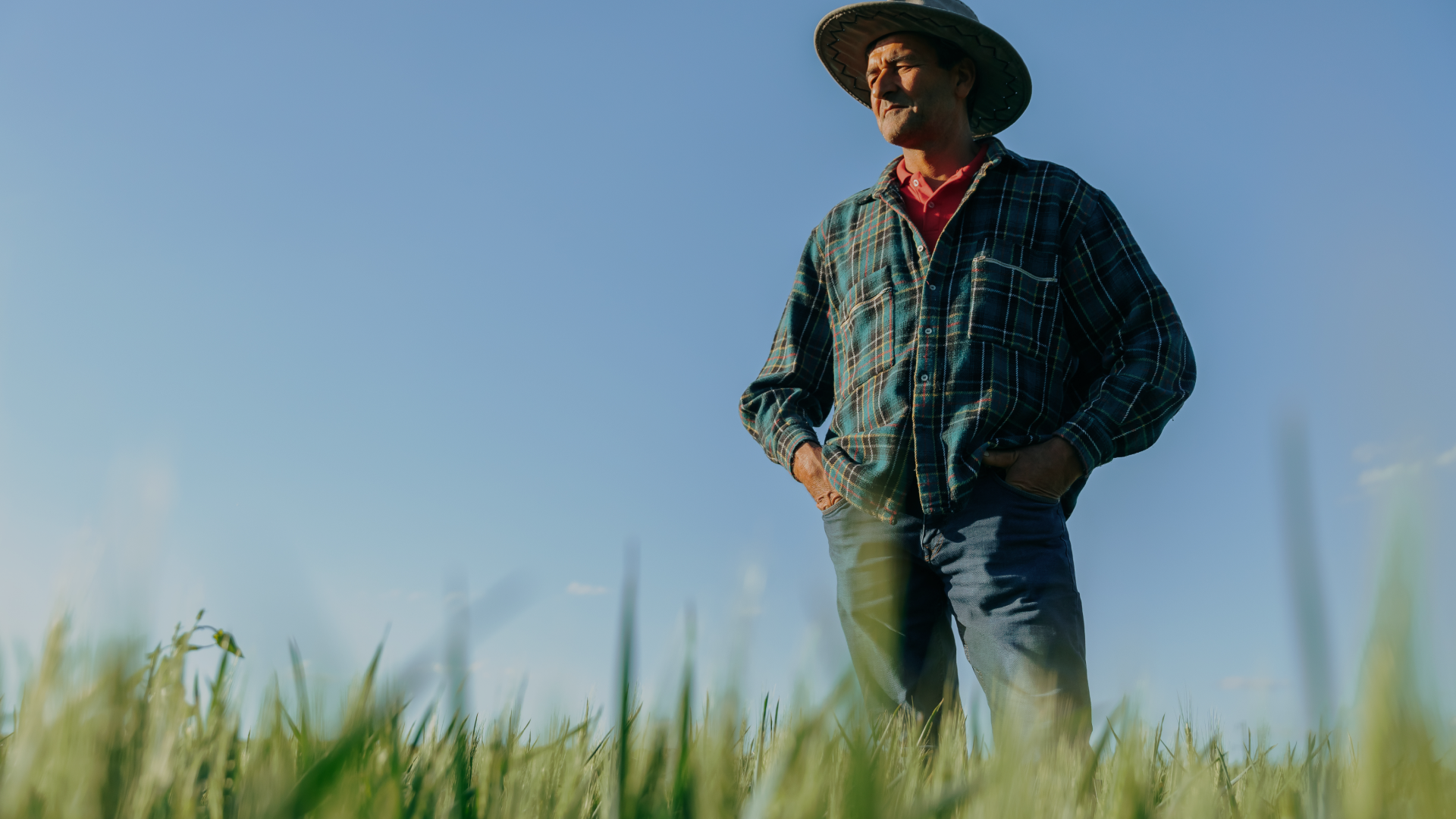As Regrow turns nine, we find ourselves entering a defining era in agriculture: one in which ‘resilience’ is no longer a stand-in for ‘sustainability’, but the foundation of how we grow, manage and protect our food systems.
People often overestimate what can be achieved in a day and underestimate what can be achieved in a decade. In other words, long-term trends outlast short-term noise. This is true for Regrow and for our industry, and serves as a guidepost for where I see the company 10 years from now.

What’s carried us through the last decade, and what will bring us confidently into the next one, isn’t just the drive that Bill and I share, or that every Regrower, past and present, brings to our mission. It’s the interplay between that drive and the evolving forces around us: the tightening and loosening of regulatory frameworks, the rise of corporate disclosures, and the jurisdiction-specific rules reshaping how supply chains operate.
Despite these forces and the short-term noise they bring, I find that it’s helpful to take a step back and reflect on the long-term trends that have been driving the changes in our industry over the last 9 years.
What have I seen in that time? The global shift toward supply chain transparency and traceability continues to strengthen, as does our understanding that resilience depends on risk-sharing with farmers; on helping them access the capital and confidence needed to transition to regenerative systems. These trends have only grown more widely accepted across both public and private sectors.
Our industry is recognizing the importance of resilience and building the frameworks for a holistic shift towards it. I’m encouraged to see this long-term trend and I’m proud of where we stand, with resilience in sight and the path to it becoming clearer each year.
Entering the era of resilience
Resilience is rapidly becoming the modus operandi, not just in agriculture but across every industry globally.
Companies are reassessing what resilience means as physical climate risks become more visible and more urgent. From shifting weather patterns to supply chain disruptions, it’s clear that having resilience in supply chain and company operations is no longer optional; it’s a fiduciary responsibility for businesses.
At Regrow, we define resilience as economic, social, and environmental strength, starting at the farm level and extending across the supply chain. For the past few years, we’ve been exploring how these dimensions interact: how healthier soil leads to stronger farms, how adaptive farms lead to more secure supply chains, and how sharing the responsibility of healthy soil between farmers and companies builds systems that last.
Our work on resilience has shown just how essential it is—yet significant challenges still stand between us and a truly resilient food system.

The challenges before us
Building the business case for investment with useful, accessible data
Early findings from our State of Agriculture Resilience Report reveal a consistent message: companies remain deeply concerned about the short- and long-term risks climate change pose to their supply chains.
The frequency and intensity of climate events are growing, threatening agricultural land, processing facilities, and the people whose livelihoods depend on them. The costs of adaptation alone are enormous, which is why blending adaptation and mitigation through regenerative agriculture has become the most effective path forward.

Resilience, in this context, is risk management for supply chains globally. It’s connected directly to business longevity and profitability. Strategies that build resilience have significant ROI, and companies are beginning to better articulate as well as capture that ROI in practice. It’s our job as industry leaders to produce the data behind resilience, show the business case for investment, and to continue building the infrastructure that makes resilience a core business strategy.
Ensuring that resilience is a pragmatic strategy
In addition to understanding the ROI of our efforts to build resilience, we’re also shifting our understanding of sustainability from a “feel-good” concept to a pragmatic strategy: one grounded in fiduciary duty, measurable outcomes, and business performance.
“Materiality is the new morality,”
as Ravi Menon,Singapore's first Ambassador for Climate Action, was cited during New York Climate Week.
This shift is a good one. It ensures that sustainability becomes part of typical business operation as a driver of resilience and long-term profitability.
Our ultimate challenge is to continue to build the groundwork beneath this understanding. How can we get the right data and enable the right stakeholders to build resilience at the scale we need across our food system?

Empowering collaboration
We can make significant progress towards our goals by unlocking collaboration opportunities across our supply chains. Early data from Regrow’s annual State of Ag Resilience Report is showing that companies struggled most this year with building partnerships across their supply chains and beyond.
We won’t move fast enough unless we work together methodically, transparently, and with shared incentives.
At Regrow, we’ve seen what’s possible when alignment happens. Over the last five years, we’ve helped hundreds of companies fund the transition for thousands of farmers, channeling more than $50 million in transition finance and abating over 1 megaton of emissions.
This impact was achieved through collaboration; through the hard, detailed work of structuring co-investments, data sharing, and trust building. To accelerate this momentum, we’re planning an industry gathering in March 2026, bringing together business leaders, investors, insurers, and farmers to co-design the next phase of agricultural resilience finance. We see these convenings as a necessary step in building holistic resilience. Keep an eye out for more information (and your invitation!) in the coming weeks.
Scaling impact through innovation
In addition to unlocking collaboration, we also need to make the data behind resilience more accessible and to make the science underpinning resilience accessible at scale. This will clear many hurdles on our path to resilience, and in this area Regrow thrives.
I’m proud of the progress Regrow has made on this front. Our AI and machine learning technologies are unlocking new levels of efficiency and insight. We’ve developed:
- Industry-pioneering generative AI models that analyze satellite imagery to automate farm practice mapping, reducing reporting burden for farmers
- AI translators that convert companies’ procurement data into geospatial sourcing maps
- Predictive tools that help model abatement potential across entire supply sheds, yet calculating uncertainty at the field level
These aren’t just technical achievements; they are enablers of transparency and scalability in regenerative agriculture. As one of the leading MRV providers globally, we see it as our duty to continually improve the accuracy, affordability, and accessibility of these tools to support a truly global transition.
Looking ahead: the next 10 years
As we review the years behind us and prepare to enter our tenth year, the path to resilience is clear for Regrow:
- Expand global partnerships that push the boundaries of what’s possible in financing resilience
- Serve new geographies with best-in-class and best-available tools
- Lower the cost and increase the scalability of MRV, enabling viable ecosystem outcomes and resilience markets
- Champion agricultural resilience as the key ROI driver behind the transition investments
- Bring in new stakeholders — financiers, insurers, and policymakers — to unlock a new wave of systemic change
And in the decade ahead, we’re anticipating breakthroughs that redefine how we understand and create value. We look forward to using scientific knowledge to validate the link between regenerative practices and the nutrient density of our food. We want to see crop insurance and farmland finance evolve to recognize regenerative systems as true risk mitigation tools. We’ll work with partners and across the industry to build transparent, traceable supply chains that reward better farming and ecosystem outcomes. And we’ll empower consumers, especially younger generations, to continue choosing brands that align their own well-being with the health of the planet.
.jpg)
Resilience is a mindset
Nine years in, I’m more convinced than ever that resilience isn’t just an outcome; it’s a mindset.
To our partners, collaborators, and to every Regrower who’s been part of this journey: thank you. You’ve built more than a company; you’ve built a movement that’s reshaping how the world grows and sustains itself.
Here’s to the next decade of resilience. I’m proud to be in it with you, colleagues, partners, peers and leaders.
Anastasia Volkova, PhD
CEO & Co-Founder, Regrow Ag



